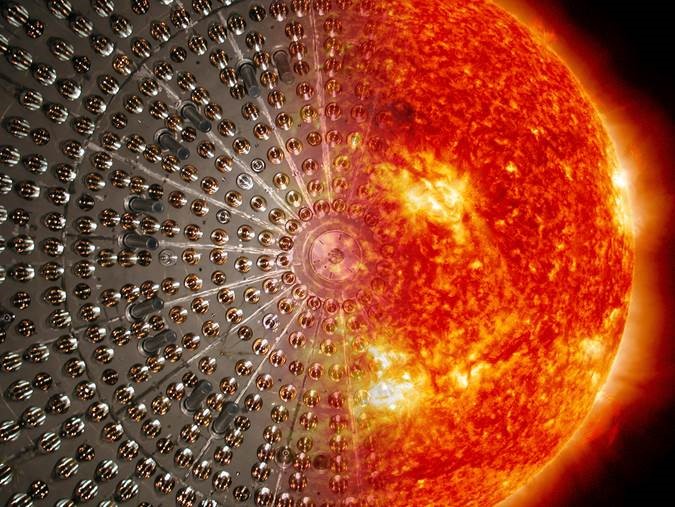Rosetta mission named Physics World 2014 Breakthrough of the Year

View of the interior of the Borexino detector and surface of the sun Ill./©: Borexino Collaboration
The journal Physics World has named the first landing of a research probe on a comet as its 2014 Breakthrough of the Year. The Physics World editorial team decided to single out the historic achievement of the scientists working on the Rosetta mission for its significance and fundamental importance to space science.
A team headed by Dr. Göstar Klingelhöfer at Johannes Gutenberg University Mainz (JGU) in Germany developed the alpha particle x-ray spectrometer on board Philae, the lander of the ESA mission to the comet Churyumov–Gerasimenko.
On November 12, 2014 the lander touched down on the comet after a ten-year journey aboard the Rosetta spacecraft. Physics World is the journal produced for members of the UK-based Institute of Physics (IOP), one of the largest associations of physicists in the world.
Listed among its ten most important 2014 breakthroughs of the year were also the recent discoveries of the Borexino experiment, in which a team of physicists from Mainz University led by Professor Michael Wurm are participating.
Shielded deep within the bowels of the Gran Sasso mountain, the experiment is designed to detect neutrinos, an elusive form of particle created during nuclear fusion in the core of the sun. Although billions of such particles penetrate every square centimeter of the planet Earth every second, they are extremely difficult to capture.
For the first time, Borexino has been able to directly detect neutrinos created during one of the most important nuclear reactions that occur in the sun, the fusion of two hydrogen nuclei.
Further information:
Dr. Göstar Klingelhöfer
Institute of Inorganic Chemistry and Analytical Chemistry
Johannes Gutenberg University Mainz
D 55099 Mainz, GERMANY
phone +49 6131 39-23282 / 39-26883
fax +49 6131 39-26263
e-mail: klingel@uni-mainz.de
http://www.ak-klingelhoefer.chemie.uni-mainz.de/
Professor Dr. Michael Wurm
Institute of Physics
Johannes Gutenberg University Mainz
D 55099 Mainz, GERMANY
phone +49 6131 39-23928
fax +49 6131 39-25169
e-mail: michael.wurm@uni-mainz.de
http://www.etap.physik.uni-mainz.de/
http://physicsworld.com/cws/article/news/2014/dec/12/comet-landing-named-physics… – Physics World 2014 Breakthrough of the Year ;
http://www.uni-mainz.de/presse/17758_ENG_HTML.php – “Alpha particle x-ray spectrometer developed in Mainz transmits first data from comet Churyumov-Gerasimenko” ;
http://www.uni-mainz.de/presse/17555_ENG_HTML.php – “Detection of pp-neutrinos provides first direct measurement of solar power at its production”
Media Contact
All latest news from the category: Physics and Astronomy
This area deals with the fundamental laws and building blocks of nature and how they interact, the properties and the behavior of matter, and research into space and time and their structures.
innovations-report provides in-depth reports and articles on subjects such as astrophysics, laser technologies, nuclear, quantum, particle and solid-state physics, nanotechnologies, planetary research and findings (Mars, Venus) and developments related to the Hubble Telescope.
Newest articles

Superradiant atoms could push the boundaries of how precisely time can be measured
Superradiant atoms can help us measure time more precisely than ever. In a new study, researchers from the University of Copenhagen present a new method for measuring the time interval,…

Ion thermoelectric conversion devices for near room temperature
The electrode sheet of the thermoelectric device consists of ionic hydrogel, which is sandwiched between the electrodes to form, and the Prussian blue on the electrode undergoes a redox reaction…

Zap Energy achieves 37-million-degree temperatures in a compact device
New publication reports record electron temperatures for a small-scale, sheared-flow-stabilized Z-pinch fusion device. In the nine decades since humans first produced fusion reactions, only a few fusion technologies have demonstrated…





















